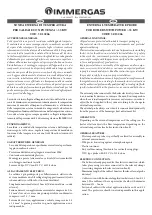
whl-648 Rev. 001 Rel. 003 Date 10.8.19
28
F. CH and DHW Pressure Relief Valves
Figure 17 - Pressure Relief Valve
An external pressure relief valve must be installed on this boiler for
both the CH and DHW loops. When installing, observe the following
guidelines. Pressure relief valves must be installed as close to the boiler
as possible. No other valves should be placed between the pressure
relief valve and the boiler. Failure to comply with these guidelines can
result in substantial property damage, personal injury, or death.
This boiler has a high-temperature shut-off switch built in as a standard
safety feature. Therefore, a “pressure only” relief valve is required.
DO NOT operate this boiler before the supplied pressure relief valve
is installed with sufficient relieving capacity in accordance with the
ASME rating plate on the boiler.
CH Loop
This boiler is provided with a CH pressure relief valve that complies
with the ANSI/ASME Boiler and Pressure Vessel Code, Section IV
(Heating Boilers). The included 30 psi CH Pressure Relief Valve must be
installed on the CH supply line to ensure a compliant installation and
safe operation. Westinghouse has supplied a ¾” X 1” bushing to aid
installation of the CH Pressure Relief Valve. The valve is meant to be
field installed. DO NOT install a CH pipe line relief valve with a pressure
rating greater than 30 psi. This is the maximum allowable CH relief
valve setting for this boiler.
WARNING
!
To avoid water damage or scalding due to relief valve operation:
•
Discharge line must be connected to relief valve outlet and
run to a safe place of disposal. Terminate the discharge line
in a manner that will prevent possibility of severe burns or
property damage should the relief valve discharge.
•
Discharge line must be as short as possible and the same
size as the valve discharge connection throughout its entire
length.
•
Discharge line must pitch downward from the valve and
terminate at least 6” above the floor drain, making discharge
clearly visible.
•
Discharge line shall terminate plain, not threaded, with a
material serviceable for temperatures of 375
o
F or greater.
•
Do not pipe discharge to any location where freezing could
occur.
•
No shutoff valve may be installed between the relief valve
and boiler or in the discharge line. Do not plug or place any
obstruction in the discharge line.
•
Test the operation of the relief valve after filling and
pressurizing the system by lifting the lever. Make sure the
valve discharges freely. If the valve fails to operate correctly,
replace it with a new relief valve.
•
Test relief valve at least once annually to ensure the waterway
is clear. If valve does not operate, turn the boiler “off”
and call
a plumber immediately
.
•
Take care whenever operating relief valve to avoid scalding
injury or property damage.
•
For boilers installed with only a pressure relief valve, the
separate storage vessel must have a temperature and pressure
relief valve installed. This relief valve shall comply with Relief
Valves for Hot Water Supply Systems, ANSI Z21.22 CSA4.4.
FAILURE TO COMPLY WITH THE ABOVE GUIDELINES COULD
RESULT IN FAILURE OF RELIEF VALVE OPERATION, RESULTING
IN POSSIBILITY OF SUBSTANTIAL PROPERTY DAMAGE, SEVERE
PERSONAL INJURY, OR DEATH.
RE-INSPECTION OF RELIEF VALVES: Valves should be
inspected AT LEAST ONCE EVERY THREE YEARS, and replaced
if necessary,
by a qualified service technician to ensure that the
product has not been affected by corrosive water conditions and
to ensure that the valve and discharge line have not been altered
or tampered with illegally. Certain naturally occuring conditions
may corrode the valve and its components over time, rendering
the valve inoperative. Such conditions can only be detected if the
valve and its components are physically removed and inspected.
Do not attempt to conduct an inspection on your own.
Contact
your plumbing contractor for a re-inspection to assure continued
safety.
Do not thread a cap or plug into the relief valve or relief valve line
under any circumstances! Explosion and property damage, serious
injury, or death may result.
FAILURE TO RE-INSPECT THE RELIEF VALVE AS DIRECTED
COULD RESULT IN UNSAFE TEMPERATURE AND/OR PRESSURE
BUILD-UP WHICH CAN RESULT IN PROPERTY DAMAGE,
SERIOUS PERSONAL INJURY, OR DEATH.
WARNING
!
DHW Loop
This boiler must be provided with a DHW pressure relief valve
that complies with local codes, but not less than valves certified
as meeting the requirements of Relief Valves for Hot Water Supply
Systems, ANSI Z21.22 CSA4.4 by a nationally recognized lab that
maintains periodic inspection of production listed equipment. A
DHW pressure relief valve is not included with the boiler, and is to be
field supplied and installed. DO NOT install a DHW relief valve with a
pressure rating greater than 150 psi. This is the maximum allowable
DHW relief valve setting for this boiler.
After installing the relief valves and filling and pressurizing the
system, test the operation of the valves by lifting the levers. Make
sure the valves discharge freely. If a valve fails to operate correctly,
replace it with a new relief valve. Ensure that the maximum BTU/H
rating on the pressure relief valve is equal to or greater than the
maximum input BTU/H rating of the combination boiler.
Summary of Contents for WBRC 140 Series
Page 21: ...whl 648 Rev 001 Rel 003 Date 10 8 19 21 E Applications Figure 10 Piping Symbol Legend ...
Page 40: ...whl 648 Rev 001 Rel 003 Date 10 8 19 40 Figure 33 Electrical Wiring Diagram ...
Page 41: ...whl 648 Rev 001 Rel 003 Date 10 8 19 41 Figure 34 Ladder Diagram ...
Page 81: ...whl 648 Rev 001 Rel 003 Date 10 8 19 81 Notes ...
Page 82: ...whl 648 Rev 001 Rel 003 Date 10 8 19 82 This Page Intentionally Left Blank ...
Page 83: ...whl 648 Rev 001 Rel 003 Date 10 8 19 83 This Page Intentionally Left Blank ...
















































